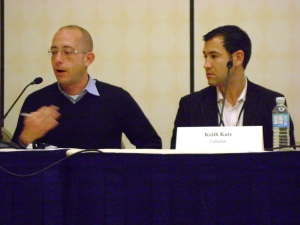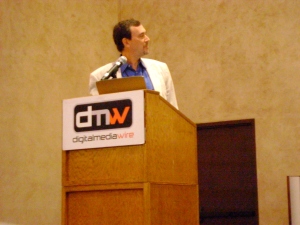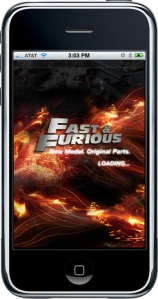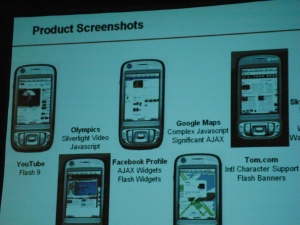I think it’s pretty obvious at this point in the game that social networking is likely to be a component of much if not most of mobile content. This panel on social networking was made up of Keith Katz, whose Cellufun company creates games with a strong social component; John Poisson is president of Tiny Pictures that allows users to share photos and videos among friends; Mikael Vinding at JYGY.com, which allows the user to create interactive mobile campaigns, and Christopher Ngyun at Bluepulse, a mobile messaging service dedicated to the mobile web. All the companies are ad-supported except for Bluepulse which is transaction-supported and JYGY.com which offers a mixed model.
Moderator Julie Ask at JupiterResearch noted that most people think of Facebook or MySpace when they think of social networking. She asked how social networking played into what each company is doing. Poisson says it’s defined as going into a community space, whether it’s a MySpace or Facebook type of model. Tiny Pictures is a much smaller version: your real social network, the ones you’ve called recently on your mobile phone. Vinding says he feels that what they does competes with Facebook in terms of an application, although they’ll never beat them at their game; but what his company does is built around the mobile platform rather than the “add-on” that Facebook is doing, said Vinding. “Everyone can create personal clubs online and free,” he said. “Through our service via mobile messaging, you can find a list of people from your torn, for example, and in a safe and anonymous way get to know them.”
Social networks are nothing more than a collection of address books, said Bluepulse’s Nguyen. But when you add mobile into it, the game changes. “Mobile is with you all the time and connections are much more likely to be interactive and maintained,” he said. “Add the 4 billion subscriptions we’re at today, and the really interesting opportunity is the mobile social networking space.”
Vinding disagreed with Nguyen’s belief that social networking is nothing more than a collection of address books. “You can update your status, which is stored and logged and can be data-mined,” he noted. “It’s a whole knowledge compendium of what a person is and what they like.”
Nguyen asked to respond. “Behavioral targeting is already proven as something that can make money, but is no where near as effective as [you think]. The value of looking at your yahoo mail traffic is a hundred-fold more important. The time aspect, not the relationship aspect is what people want, and mobile gives you that.”
Cellufun’s Katz said it boils down to the definition of social networking. “Social networking can be a group that has an interest in something and come together in large groups to pursue that,” he said. “We have millions of people into playing casual games on their phones and have learned it can be more fun doing it with a group with similar interests.” It would be hard to describe any part of a group that gets together with similar interests as not being social networking, added Tiny Pictures’ Poisson.
How do you monetize social networking? asked Ask. “You have to have a lot of folks doing it to make it work,” agreed Katz. “We have a pretty simple way of making money which is through display ads. We also do things that we can do because we’re more than a portal. We have a virtual economy, to play games or buy various goods. We’re now incorporating real brands into that mall. So you have to have a lot of people and find other ways of advertising aside from banner ads.”
Most of the growth of his business has been word-of-mouth, said Katz. “There’s also the stickiness factor and that becomes a more compelling message to advertisers.” “The nature of our business is based on the intimate nature of the phone, and it’s naturally viral because you have to get your friends to sign up,” said Poisson. “But you’re much more likely to come back because if I don’t send photos or comment on my friends photos, people will wonder where you are. It’s built into the nature of what we do. People get into the habit of checking every few hours. We’re a totally free, advertising-supported site.”

Tiny Pictures' Poisson; Cellufun's Katz looks on
The most interesting revenue-creation model in his world is to be able to deliver sponsored content into the stream; the user could opt into a “Tropic Thunder” channel, which gave them behind-the-scenes footage of the movie in addition to their friends’ photos. Then consumers had a conversation around that comment. “That speaks to what these media-rich devices can do,” he said.
Social networking is like a big distribution channel, said Vinding. The vast majority of revenue on a Facebook is advertising. Yes, advertising is an immediate thing that can be done now, he said, but don’t just look at this as a social networking site on a PC, because the mobile is also a payment device, especially with premium text services that exists in every country. The third prong they’re looking at is media polling or surveys.
“You make money from the verbs not the nouns,” said Nguyen. “Facebook is a big noun, not a verb; it’s in the action that people express an intent and that’s where the money is to be made. We’re perfectly happy not to have our own social network. I fail to see the significance of social networks as a major money maker; it’s a collection of powerful address books.”
Will social networking on the cell phone be an extension of what goes on on the PC, or something quite different. “I think it’s a very different experience, with the always with you factor, the constant connection,” said Poisson. “Sharing bits of information with your friends all day long, engaging on the go is very different than what’s on the computer.”
Ask noted that teenagers and young adults want that constant checking-in. Will this kind of social networking be limited to youth, or to vertical communities? “I think it feels most relevant to the youth market: they’re comfortable with the technology and comfortable sharing,” said Poisson. “I would never have told my parents what I was doing every day, but my 25 year old sister is constantly texting, calling, sharing. And my mom is now sharing what she’s doing. It spreads from that.” Vinding said he’s seen vertical applications of that, from automotive to medical. “It’s around a specific interest or condition and it expands from there, incorporating all ages,” he said.
Why is the immediacy of the cell phone important for this kind of vertical content? “You can stay in touch, if you’re going someplace,” said Vinding. “The method of access is also important. Not everyone has a PC. Everybody has a mobile phone. If you were doing something where people needed an easy way to update everyday, it’s easy and it’s in your hand. It’s not just immediacy–it’s accessibility.”
“Immediacy is the one thing that’s different with the mobile phone and not on the PC,” agreed Nguyen. “It’s something that you just don’t want but because everyone else has it, you have to.” Do we really need things immediately? “Let’s not conflate immediacy with urgency,” said Poisson. “There is something about immediacy that strikes us all as wasteful or ridiculous. The best example with the younger generation is text-messaging which seems like a stupid, stupid way to communicate. But it has by all measures supplanted every other form of communication for this generation. It doesn’t interrupt you (although you can argue that) but a big part of its value is its immediacy. It’s not about urgency, it’s about now.”
Nguyen said “I think people will die without this stuff.” “I agree with John but I’d push the point further. Immediacy does mean urgency. Let’s say we need to know the population of Zimbabwe. A few years ago, it was reasonable to come back with an answer in a few days. Today, if you can’t come up with an answer in 5 minutes, you’re gone. In the future, if you can’t come up with the answer in 5 seconds, you’re gone. Immediacy is fundamentally transforming media.”
“What the iPhone does is – the UI is completely different which encourages more usage, people who use it are more likely to use gmail mobile and the WiFi platform: all those things conspire to say that we’re at an interesting shift,” said Nguyen. “I don’t think that in a few years we’ll dispute whether you need that piece of information in 5 minutes. You’ll need it.”
Ask asked the panelists if location play a role in social networking services. “We’re trying to figure that out,” admitted Katz. “We’re creating a world travel game, and what we’re doing is implementing a guide system so that if you live near that city you can be a guide and earn extra points for doing that. We think that will create more of a bond. We already see that people with sub-interests beyond gaming are forming their own groups on the site. For example, on their own, hundreds of people are participating in a site on mobile pets, virtual pets, that people are feeding. We’re trying to find ways that can help our users forge alliances based on geography which we think will increase the stickiness of the site.”
Vinding said that location is fun and interesting but in terms of social networking, one of the great benefits is that you can talk to people around the world. “I don’t necessarily want to talk to someone near me unless it’s dating or meeting local people to have beers,” he said. “We don’t see a lot of demand for location-based demands.” The scale and scope issues of location often aren’t discussed, said Poisson. “Location has the potential to be industry and experience changing but there’s a big difference between regionality and sitting in Conference Room 1 at the Marriott. Even with my closest friend, that’s a tough value proposition to get. People don’t even want their close friends to know where they are.”
One-quarter of teens want to track where their friends are, said Ask. They don’t want to be tracked, but they want to be able to track. “If I have taken 10 pictures in a restaurant in San Francisco and Ian and ten of my friends also take those pictures, maybe we’re at the same birthday party and put those pictures together,” said Poisson “I think that’s a lot more interesting than Where’s Ian right now?”
It’s not new to know where you are, said Nguyen. “If you’re late for a meeting, you’ll be able to give a status update,” he said. “Occasionally information about time will be useful but won’t add much to the transactional basis.”


 the movie.
the movie.
 That’s true. If you type “mobile marketing” into Google, what will come up is everything from an ad agency that doesn’t have any technology all the way to Verizon and everyone in between. It’s helpful to draw ‘coarse grain segmentation’ of the marketplace. One is mobile ad networks. That’s basically doing advertising; people will sell inventory and space to take it into mobile. A second is building mobile websites, which helps people to take online properties and bring them into the mobile world. The third is around online direct marketing, or the mobile equivalent of direct marketing. That’s the category that Mozes is in. Some people call it CRM, or customer relationship management, but that means a lot of different things so I try to stay away from that term. It is about a customer community and having an engagement with them, and we do that for sure. There’s also a fourth category, which is mobile commerce or m-commerce. That’s taking your electronic storefront and bringing it into the mobile realm.
That’s true. If you type “mobile marketing” into Google, what will come up is everything from an ad agency that doesn’t have any technology all the way to Verizon and everyone in between. It’s helpful to draw ‘coarse grain segmentation’ of the marketplace. One is mobile ad networks. That’s basically doing advertising; people will sell inventory and space to take it into mobile. A second is building mobile websites, which helps people to take online properties and bring them into the mobile world. The third is around online direct marketing, or the mobile equivalent of direct marketing. That’s the category that Mozes is in. Some people call it CRM, or customer relationship management, but that means a lot of different things so I try to stay away from that term. It is about a customer community and having an engagement with them, and we do that for sure. There’s also a fourth category, which is mobile commerce or m-commerce. That’s taking your electronic storefront and bringing it into the mobile realm. episodes directly to their handheld devices.Showtime also launched its password-protected website, developed with online video platform Brightcove, allowing voters to mark their ballots online.
episodes directly to their handheld devices.Showtime also launched its password-protected website, developed with online video platform Brightcove, allowing voters to mark their ballots online.













